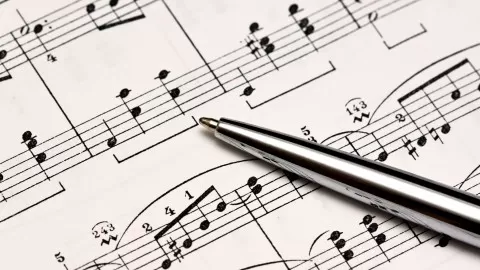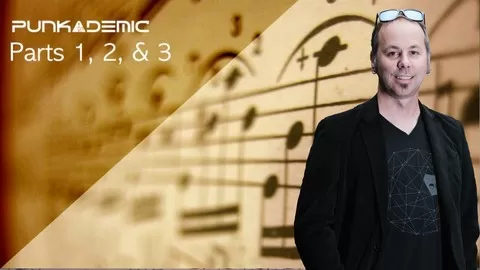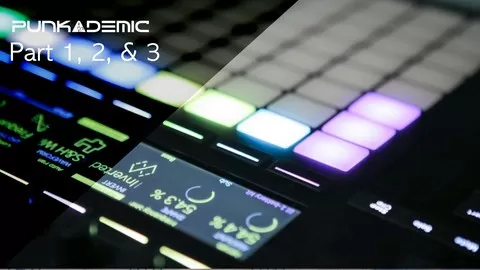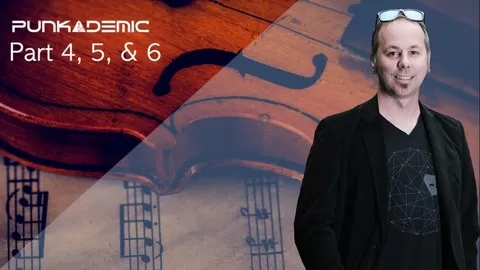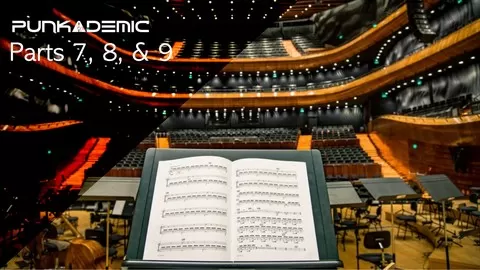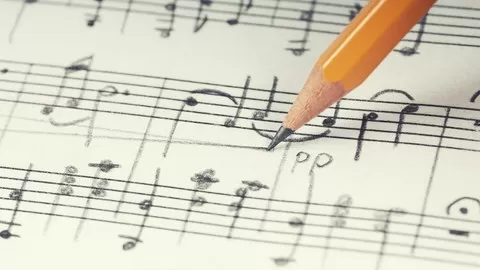✓ The definition of music
✓ The elements of music (rhythm & pitch)
✓ Division of pitch into melody and harmony
✓ Rhythmic notation
✓ Understanding relative durations of sound
✓ The whole, half, quarter, 8th and 16th notes
✓ Why notes are named the way they are
✓ Relative durations vs. assigning numerical values
✓ The unit of measurement
✓ Beat
✓ Tempo
✓ Meter
✓ Distinguishing between rhythm and meter
✓ Bar lines and measures
✓ Time signatures
✓ 2/4, 3/4 and 4/4 meters
✓ Determining the meter without a time signature
✓ Natural division of rhythms
✓ Strong and weak pulses
✓ Rests
✓ Assigning numerical values to rests
✓ The whole rest and meter
✓ Dotted notes
✓ Numerical values of dotted notes
✓ History of dotted notes
✓ Dotted rhythms
✓ The 3:1 ratio in dotted rhythms
✓ The tie
✓ Ties vs. dotted notes
✓ Advantages and disadvantages of notating with ties vs. dots
✓ Re-designation of the unit
✓ 3/8 and 6/8 meters
✓ New numerical values of notes
✓ Understand relative durations with regard to a new unit of measurement
✓ Strength of pulses
✓ Designating the half note as the unit
✓ Notating 2/2 meter or “cut” time
✓ Numerical values of note durations in 2/2 meter
✓ Comparison of 4/4 meter and 2/2 meter
✓ Reasons for 2/2 meter
✓ Classifying meters
✓ Simple meter and compound meter
✓ Duple, triple, and quadruple meter
✓ Complex meter
✓ Artificial divisions of the beat or beats
✓ Artificial division of parts of the beat
✓ Common types of tuplets
✓ Definition of triplets & duplets
✓ Identifying triplets & duplets
✓ Ratio of triplets & duplets
✓ Numerical value of triplets & duplets
✓ Artificial divisions in relation to simple and compound meters
✓ Sound waves
✓ Frequency
✓ Indefinite vs. definite pitch
✓ Modern vs. ancient definition of pitch
✓ Pitch experiments
✓ Introduction to the staff
✓ How the mind sees number
✓ Ledger lines
✓ Clefs
✓ Movement on the staff (step, skip, repeat)
✓ The musical alphabet
✓ Letter names on the staff
✓ The grand staff
✓ Direction of note stems (and rationale)
✓ Introduction to the keyboard
✓ Groups of black keys
✓ Letter names of keys
✓ Correlation of staff to the keyboard
✓ Half steps and whole steps
✓ Sharps and flats on the keyboard
✓ Enharmonic equivalents
✓ Enharmonic keyboard notes
✓ Reading sharps and flats on the staff
✓ Sharps and flats within measures
✓ The natural sign
✓ The definition of interval
✓ Melodic vs. harmonic intervals
✓ Identifying intervals on the keyboard
✓ Identifying intervals on the staff
✓ Ratios and intervals
✓ Pythagoras and the monochord
✓ Consonance and dissonance
✓ Definition and history of the modern scale
✓ The major scale
✓ Intervals and the major scale
✓ Basis of the scale
✓ Basis of the whole tone
✓ Greek tetrachords
✓ Greek semi tone and whole tone
✓ Constructing scales on the keyboard
✓ Constructing scales on the staff
✓ Definition of “key”
✓ The key signature
✓ The circle of 5ths
✓ The order of sharps
✓ The order of flats
✓ How to determine the key from the sharps/flats
✓ How to determine how many and which sharps/flats are in a given key
✓ Enharmonic keys
✓ Interval number vs. interval quality
✓ Major, minor and perfect interval qualities
✓ Determining an intervals’ number and quality
✓ Connection of interval qualities to the major scale
✓ Identifying intervals on the staff
✓ Augmented and diminished interval qualities
✓ How augmented and diminished intervals are formed
✓ The double sharp
✓ Why the double sharp is necessary
✓ The double flat
✓ Why the double flat is necessary
✓ The tritone
✓ Abbreviations for interval qualities
✓ Enharmonic intervals
✓ Complementary intervals
✓ Which qualities, when inverted, become which qualities
✓ Simple intervals
✓ Compound intervals
✓ Reducing compound intervals
✓ How to determine the quality of compound intervals
✓ Open and close harmony
✓ The difference between intervals and chords
✓ Major and minor chords
✓ Deriving the ratio of the major and minor 3rds using the monochord
✓ The Pythagoras experiment and the major chord
✓ Block and broken chords
✓ Augmented and diminished chords
✓ Music’s move from the horizontal to the vertical
✓ Mathematical proportions of the major, minor, augmented and diminished triads
✓ Understanding the harmonic mean
✓ The harmonic mean and the major chord
✓ Understanding the arithmetic mean
✓ The arithmetic mean and the minor chord
✓ The geometric mean and the augmented and diminished chords
✓ Relation of chords to the major scale
✓ The number of possible triads constructed from the pitches of the major scale
✓ Order and quantity of triad qualities formed from the major scale
✓ Roots of chords, scales, and keys
✓ Comparison of the major and minor scales
✓ Tetrachords in minor scales
✓ The natural minor scale
✓ Constructing natural minor scales on the keyboard & staff
✓ The harmonic minor scale
✓ The melodic minor scale
✓ Ascending vs. descending melodic minor scale
✓ Constructing harmonic minor scales on the keyboard & staff
✓ Constructing melodic minor scales on the keyboard & staff
✓ Relative keys
✓ Determining the relative minor
✓ Determining the relative major
✓ Determining the key of music with shared key signatures
✓ Parallel keys
✓ Difference between parallel and relative keys
✓ Relation of chords to the natural minor scale
✓ Order and quantity of triad qualities formed from the natural minor scale
✓ Relation of chords to the harmonic minor scale
✓ Order and quantity of triad qualities formed from the harmonic minor scale
✓ The major scale degrees
✓ Naming the scale degree using Roman numerals
✓ Naming triads using Roman numerals
✓ Benefit to using degree vs. letter name
✓ Primary chords and their importance
✓ Relationship between chords
✓ Chord inversions
✓ Root position, 1st inversion and 2nd inversion
✓ Intervals in chord inversions
✓ The root rule
✓ How to identify chord inversions by name, quality and inversion
✓ Voices of a chord
✓ Voice leading
✓ Inversions and the primary chords
✓ Chord progressions
✓ Use of inversions to improve transition between chords
✓ Introduction to function
✓ Function names of the scale degrees
✓ Extending the triad
✓ Dominant seventh chords
✓ Other names and notation of the dominant seventh chord
✓ Why the dominant seventh chord is named the way it is
✓ Inversion of the dominant seventh chord
✓ 3rd inversion
✓ Finding the root in a dominant seventh chord
✓ How to identify a dominant seventh chord
✓ Dominant seventh chords with missing notes
✓ Major 7th chords
✓ Minor 7th chords
✓ Diminished 7th chords
✓ Musical punctuation
✓ Perfect authentic cadence
✓ Imperfect authentic cadence
✓ Half cadence
✓ Plagal cadence
✓ Deceptive cadence
✓ Hexatonic scale
✓ Whole tone scale
✓ Chromatic scale
✓ Pentatonic scale
✓ Tonal music
✓ Tonal centers
✓ Polytonal music
✓ Atonal music
✓ Free atonal
✓ Strict atonal
✓ Twelve-tone technique
✓ Tone rows
✓ The ancient Greek modes
✓ History of the church modes
✓ Modern modes
✓ The harmonic series
✓ Overtones
✓ Fundamental of a pitch
✓ Complex vibration of a string
✓ What the numbers of the harmonic series express
✓ Hearing overtones (and experiment)
✓ Timbre
✓ Nature’s hierarchy of harmonic sound
✓ Objective measurement of consonance and dissonance
✓ History of consonance and dissonance
✓ Tuning pitches
✓ Brief history of tuning systems
✓ Pythagorean tuning
✓ Just intonation
✓ Equal temperament
✓ Definition of cents
✓ Tuning of the modern piano
✓ Benefits and shortcomings of the different tuning systems
✓ Apps that demonstrate and compare some of the tuning systems
✓ Overview of the four main periods of western art music
• those who want more than just definitions and terms, but also want the “why”
• beginners to advanced music students
• musicians who want to improve their reading and musical performance
• songwriters and composers (a firm grasp of music theory is necessary to excel in your art)
• any person wanting to learn more about music
Jonathan Peters has created 9 courses that got 4,350 reviews which are generally positive. Jonathan Peters has taught 23,562 students and received a 4.6 average review out of 4,350 reviews. Depending on the information available, we think that Jonathan Peters is an instructor that you can trust.
